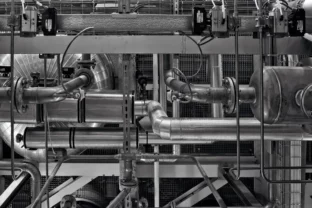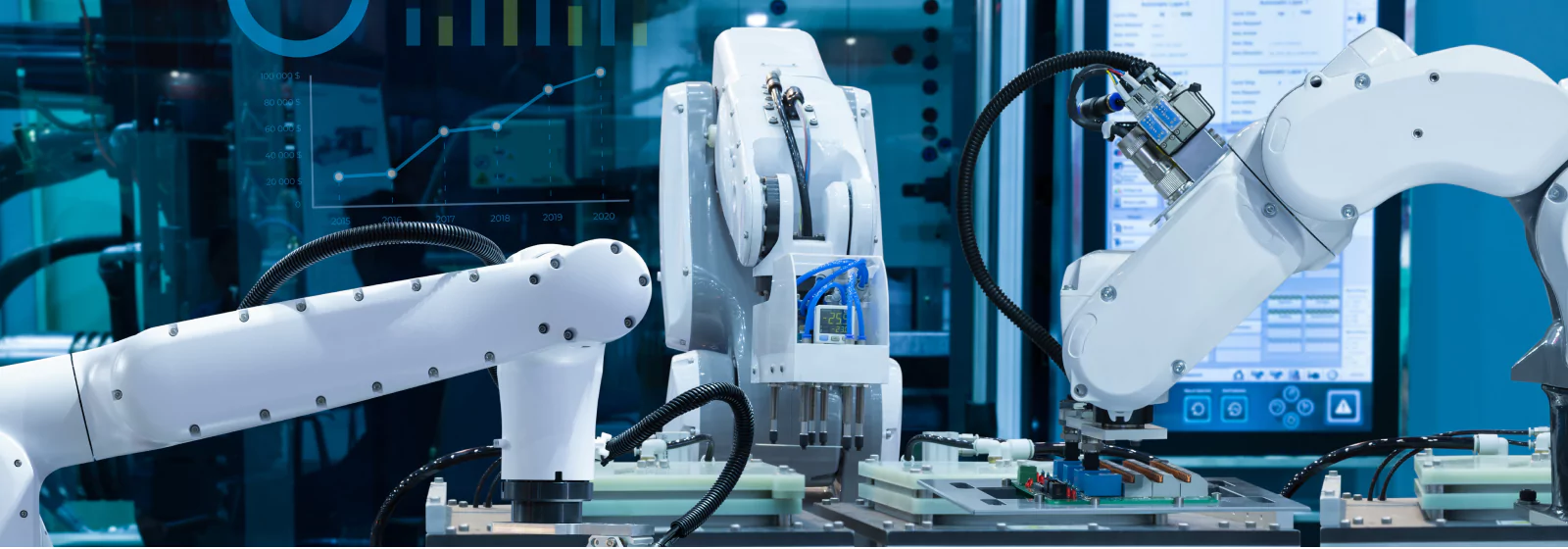
The Case for Building Automation Systems (BAS): Overcoming Barriers to Adoption
Summarize:
You’ve likely noticed – energy costs are rising fast. Every year, they increase by an average of 3%, putting a significant strain on commercial buildings. But there’s good news: according to the U.S. Department of Energy, a Building Automation System (BAS) can cut utility bills by up to 30% annually.
It’s no surprise, then, that nearly 60% of large commercial buildings in the U.S. have already adopted BAS to manage HVAC, lighting, and energy consumption. Yet, adoption among small to mid-sized buildings (under 50,000 square feet) remains low – only 13% use this technology.
So, what’s holding smaller businesses back?
At Yalantis, our experts in smart building solutions analyzed the biggest roadblocks to BAS adoption and whether it makes financial sense for smaller businesses to invest in automation. In this article, we’ll break down everything you need to know, from BAS benefits to implementation options and real-world use cases.
Let’s start with the basics: what is BAS, and how does it work?
What is BAS, how does it work, and why do you need it?
A Building Automation System (BAS), also known as smart building technology, Building Automation Controls, or Building Automation and Control Systems, is much more than just smart metering for buildings. It’s a distributed control system that integrates various building functions into one centralized platform, making your facility smarter and more efficient.
BAS controls key building operations such as:
- Heating, Ventilation, and Air Conditioning (HVAC)
- Lighting
- Utility monitoring (water, gas, electricity)
BAS systems collect data, process it in real time, and automate adjustments to reduce costs.
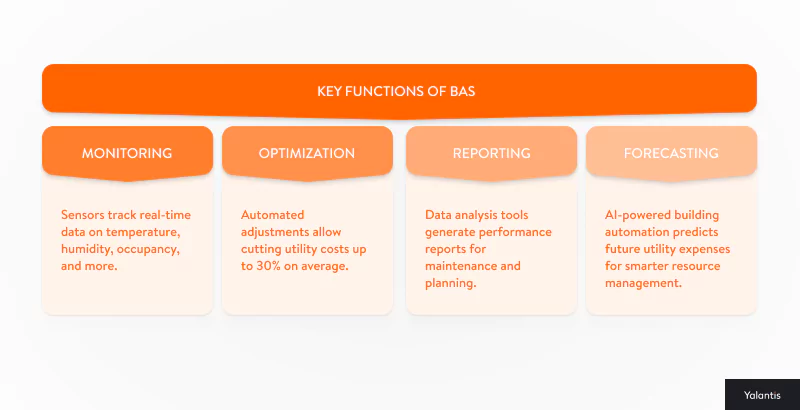
Such systems can:
- Maintain optimal climate to keep temperature and humidity within a desired range
- Automate lighting, adjusting it based on occupancy, with zero unnecessary expenses
- Monitor performance to track energy consumption and detect any device malfunctions
- Alert managers in case of a system failure or abnormal performance
Now that we have answered the main question, “What is BAS?”, let’s see how BAS systems work in more detail.
How BAS functions
BAS, or Building Automation Controls, are built on a layered architecture that works like the nervous system of your building. BAS transforms raw environmental data into intelligent insights for automated building management.
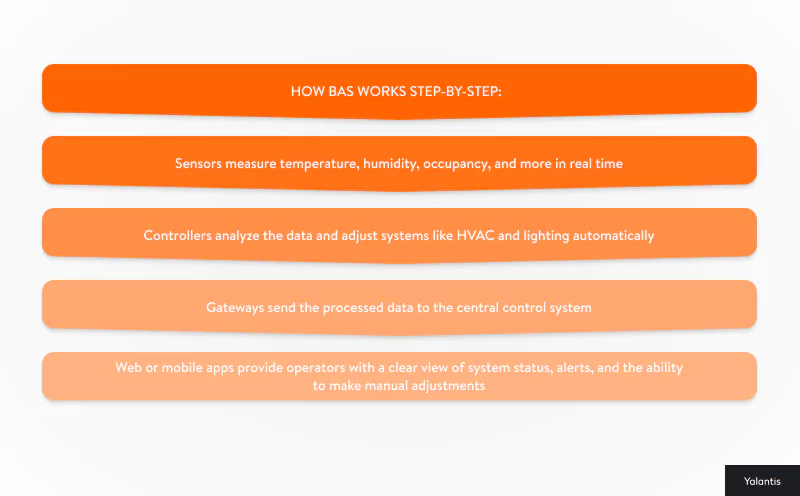
Let’s now dive into the main advantages of implementing a BAS in your building.
Business impact of BAS: energy, efficiency, well-being
Whether it’s a brand-new building or an older property retrofitted with the latest technology, Building Automation Systems are proving their value by saving money and streamlining operations, often delivering ROI faster than you’d think.
To see how BAS allows homebuilders to save costs, we can apply the “3-30-300 rule”.
On average, companies spend about $3 per square foot on utilities, $30 on rent, and $300 on payroll each year. This rule clearly illustrates the scale of each expense – small savings in utilities can have a big impact overall.
Building automation systems make a huge difference, impacting all three cost areas:
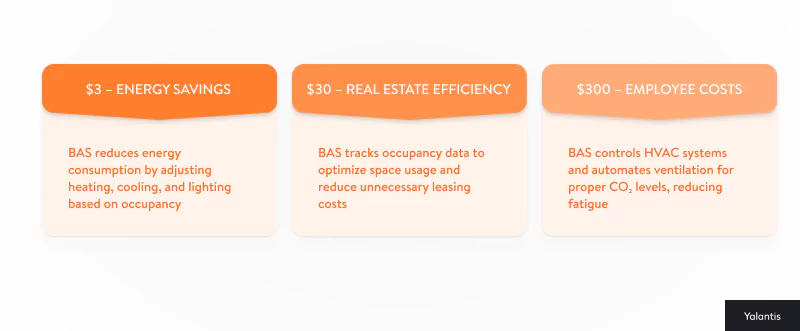
Let’s take a look at two real-life examples that showcase these benefits.
At 45 Broadway in Manhattan, a 32-story office building with outdated thermostat controls, the decision was made to upgrade to an AI-driven BAS. The system adjusted dynamically – if a cold front was coming, it started warming the space in advance; if the sun began to beam on one side, it automatically closed heat valves.
In just 11 months, this smart approach delivered:
✔ 15.8% reduction in HVAC energy consumption
✔ $42,000 in annual savings
✔ 37 metric tons of CO₂ emissions cut
Meanwhile, in Benicia, California, a Performance Contracting Office Building upgraded its HVAC and lighting systems with advanced controls to create a healthier, more efficient workplace. Employees immediately noticed the difference:
✔ Better air quality
✔ More consistent temperature control
✔ Noticeably quieter operations
Both of these cases show that building automation solutions aren’t just about energy savings. They also cut environmental impact and enhance tenant well-being.
Now, the big question: if BAS is so beneficial for commercial building automation, why is only 13% of small and mid-sized buildings adopting it? Here’s the answer.
Inspired by the $42,000 in annual savings? Let’s calculate the potential ROI of a Building Automation System for your specific property.
What stops businesses from implementing BAS systems?
Building automation controls are widely used in large commercial and government buildings, but they remain uncommon in smaller commercial properties. The reasons vary, but here are the main hurdles keeping businesses from adopting BAS:
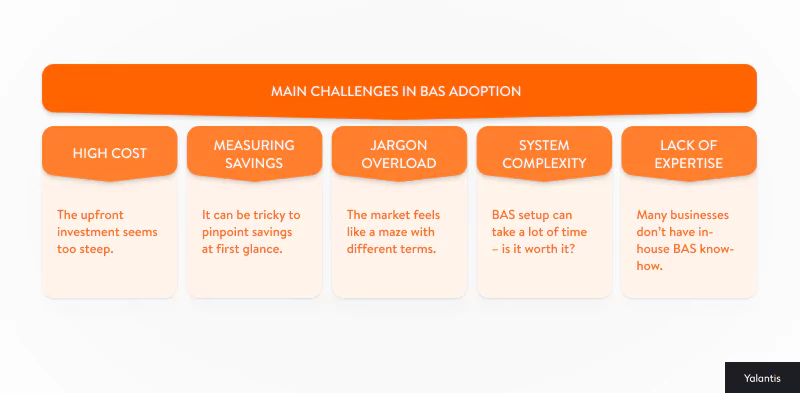
Let’s break these down and see if they’re real deal-breakers or just common fears that can be solved.
1. High cost
The first reason that stops businesses from adopting Building Automation Systems is – you guessed it – costs. But is implementing a BAS really as expensive as it seems? Let’s break it down by comparing two options: ready-made BAS vs. custom-built systems.
Many businesses start with off-the-shelf solutions like Niagara because they seem more affordable upfront. However, while the initial investment may be lower than a custom-built system, costs quickly add up as you scale.
Here’s what you need to know:
- Ready-made BAS software pricing is sneaky. Companies often don’t show you the full cost upfront. Instead, they charge based on the number of devices and features you use, sneaking in extra fees under the radar. You end up paying more for every additional sensor or control point than you might expect.
- Pricing for small businesses is even worse. Vendors often charge more per sensor or control point because they’re less incentivized to drop prices on a small account, leaving you with a higher overall bill.
- Margins and pricing tricks. Vendors might sell you the BAS hardware at a loss to win your business, only to recoup that loss by chargeing high prices on related products like sensors, controllers, and HVAC systems. They play with margins, meaning what looks like a good deal at first might not be once you factor in all the extras.
- Service contracts are a cash cow. Vendors target at least a 50% profit margin on service calls. Even if you manage to negotiate a slightly lower margin by bundling services, you’re still paying a premium for ongoing support.
Let’s break down the costs of buying a ready-made BAS:
- Upfront cost: typically ranges from $2.50 to $7 per square foot. For a 50,000 sq ft building, that’s roughly $125,000 to $350,000 initially.
- Recurring costs: vendors often charge ongoing fees based on the number of devices or data points. Expect to pay about $1,000 to $2,000 per month for licensing and maintenance.
- 3-year total: combining the initial investment with recurring fees, a ready-made solution could cost between $557,000 and $1,078,000 over three years.
Not such a bright picture, right?
The good news is that you can invest in a custom BAS and avoid vendor lock-in and recurring fees that will grow with each building.

Great, but what about pricing?
Here, the cases vary depending on the project scale and the vendor’s pricing, but at Yalantis, we offer such cost estimates for a single environment:
- $500/month – a good start for small setups and MVPs
- $2,000/month – ideal for mid-sized businesses with more automation needed
- $4,500+/month – full-scale, enterprise solutions with deep customization
With a custom BAS, you pay significantly less in the long run, especially when scaling across multiple buildings without recurring monthly fees.
If you want a system that’s built for your specific requirements, grows with your business, and keeps costs predictable, a custom BAS is the way to go.
2. Difficulties in measuring savings
One of the biggest challenges businesses face when considering BAS is proving its financial impact. Without clear numbers, justifying the investment becomes difficult.
But here’s the thing: when you can see your expenses, it’s much easier to reduce them. That’s exactly what BAS enables: it gives you full visibility into energy consumption and highlights opportunities for savings.
Some U.S. cities, like Milwaukee, are even considering ordinances that would require all commercial and residential buildings over 50,000 square feet to report their energy usage annually. The logic is simple: what gets tracked gets saved.

BAS takes this a step further. It doesn’t just track energy consumption – it actively optimizes it.
To give you a real-world example, Yalantis developed a BAS system that not only automated lighting, HVAC, and power management based on temperature, humidity, and occupancy data but also calculated the savings in real time. The company, a smart business center in Denmark, with 8 office buildings under management, was drowning in high energy costs and data overload. Their old system couldn’t accurately track energy usage or show real savings, making it difficult to see expenses and plan them.
By integrating off-the-shelf sensors and gateways, we kept hardware costs low, and our machine learning algorithms forecasted utility expenses and optimized energy use. With remote monitoring in place, the system continuously measured and updated the savings figures, providing clear, actionable insights.
In just 12 months, we delivered the first version of the system, allowing them to gain complete control over their buildings while visibly cutting energy and operational costs.
3. Jargon overload
One of the biggest hurdles for businesses considering Building Automation Systems (BAS) is the overwhelming amount of technical jargon. Terms like LoRaWAN, WiFi, MQTT, and a host of other specifications can make BAS seem far more complex than it actually is.
The key to overcoming this barrier is partnering with experts who can break down these details into clear, understandable terms. At Yalantis, we specialize in demystifying BAS. We explain the differences between various protocols and help you understand how each one fits into your overall strategy. For instance, let’s look at the two most common protocols: LoRaWAN and WiFi in BAS.
LoRaWAN is the go-to for large buildings. A single gateway on the roof can cover 20+ floors, eliminating the need for additional routers or repeaters. However, it sends updates only a few times per hour, making it ideal for non-urgent data like energy usage, water consumption, or air quality monitoring. If you require real-time control, like instantly adjusting HVAC systems or responding immediately to occupancy changes, LoRaWAN might not be sufficient. In those cases, protocols that support continuous data flow, such as MQTT over WiFi, are a better fit.
MQTT over WiFi is best for real-time monitoring. If your system needs frequent updates, like adjusting HVAC systems based on occupancy or temperature changes, WiFi protocol ensures continuous data flow. However, it requires a robust network infrastructure and may struggle with coverage in larger buildings.
Here’s a quick comparison:
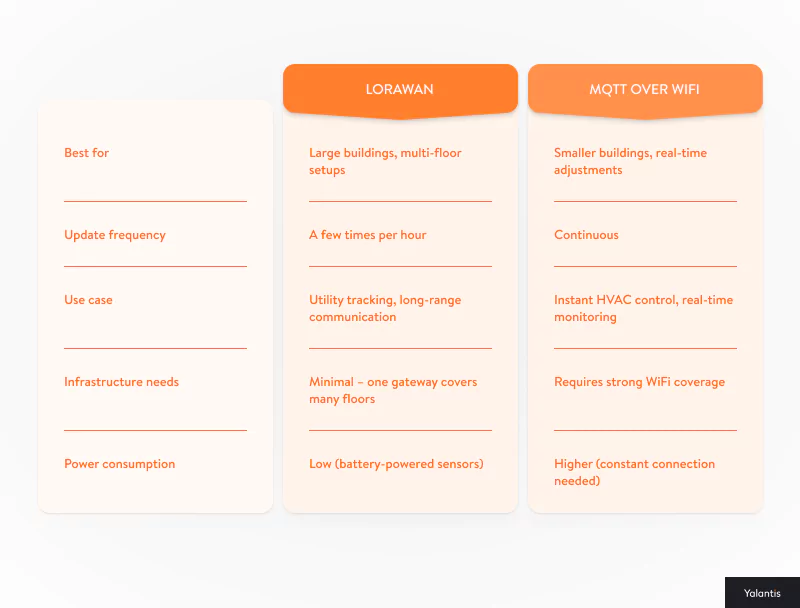
In short, while the world of BAS may seem filled with confusing jargon, the right partner can simplify each step of BAS implementation.
4. System complexity
Another major reason businesses hesitate to implement BAS is its complexity. It’s true that setting up a smart, fully automated system isn’t a weekend project, but it’s also not an impossible task that takes years. With the right approach, a BAS can be developed and deployed in less than a year, even if you’re starting from scratch.
For example, we built a hotel energy management system from the ground up in just 10 months. A hotel technology company wanted to sell smart outlets and light switches to major hotel chains. Their goal was to help hotels reduce energy waste while maintaining top-tier guest comfort. They needed custom sensor hardware that could seamlessly integrate into existing hotel infrastructure without disrupting guests.
Our solution included:
✅ A tailored HVAC and energy management system to automate heating, cooling, and lighting based on occupancy.
✅ Custom-built smart sensors designed specifically for hotel environments, ensuring smooth integration.
✅ Zero installation disruption – hotels could adopt the system without affecting daily operations.
The result? A fully functional, scalable energy management system delivered in under a year. Now, the company can offer a smart, cost-saving solution to hotel chains worldwide.
So while BAS is complex, the right development partner can turn complexity into efficiency without years of waiting.
5. Lack of expertise
One of the biggest reasons businesses hesitate to adopt BAS is a lack of in-house expertise. Building automation requires specialized knowledge in IoT, sensor networks, and system integrations – skills that most companies simply don’t have on hand. But hiring an in-house team for BAS development isn’t always practical, and finding the right external partner can feel like a challenge. Engaging professional IoT consulting services can help businesses navigate technical complexities, select the right protocols, and ensure their building automation system is efficient, scalable, and future-proof.
To overcome this, choose a company with a proven track record in BAS development. Look for a team that has already delivered similar projects and understands both the technical and business aspects of automation.
Then, build a prototype. This allows you to test their capabilities without committing to a full-scale project. If they deliver on their promise during the prototype phase, you can move forward with confidence.
To give you an idea of how it might work, here’s how Yalantis approaches custom BAS implementation.
Need help building the right automation setup?
Our team’s got your back.
How Yalantis can help you implement BAS in 6+ months
At Yalantis, we engineer smart automation solutions tailored to your building’s needs. Whether you’re looking for a cost-effective setup or a fully customized system, we handle everything from sensor integration to AI-driven forecasting.
Don’t guess – start with the prototype
We kickstart the process by developing a prototype that includes:
✅ Energy tracking. We break down consumption by building and individual devices so you know exactly where your energy is going.
✅ Smart analytics. View energy usage trends by the hour, day, or week to identify patterns and optimize costs.
✅ Total visibility. Get a complete picture of your building’s energy footprint, helping you cut waste and boost efficiency.
✅ Instant detection of inefficiencies. Real-time monitoring in BAS spots anomalies before they turn into expensive problems.
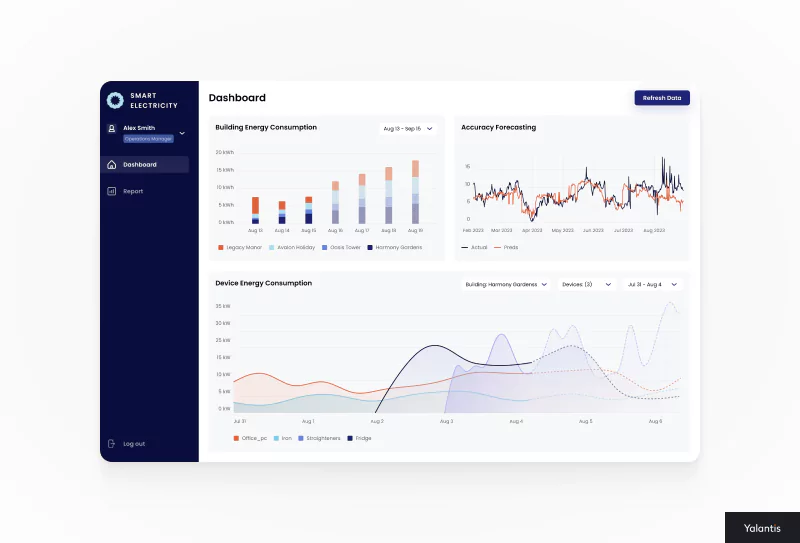
Whether you’re managing offices, a hotel chain, or need industrial automation with BAS, we make sure your building runs efficiently with minimum energy waste and maximum control.
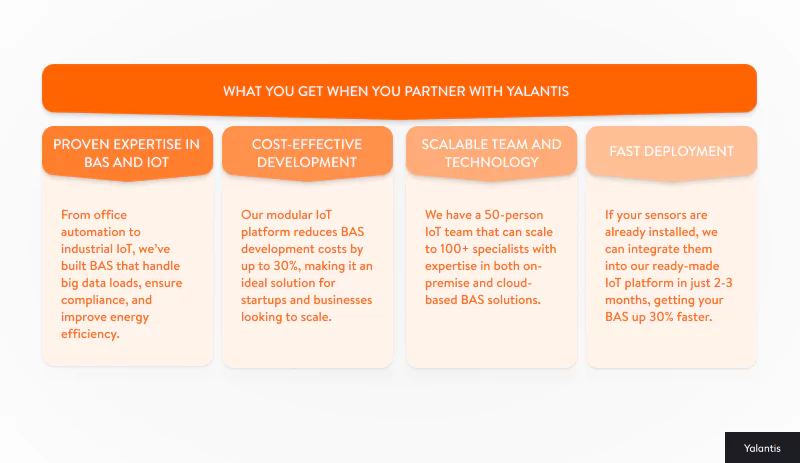
Our BAS development process
Our approach to developing energy-efficient BAS systems follows a structured, step-by-step process:
1️⃣ Data collection. We integrate sensors that collect real-time data on energy use, occupancy, and environmental conditions.
2️⃣ Data analysis. AI, ML, and BI tools process this data to detect inefficiencies, forecast trends, and optimize performance.
3️⃣ Automation. The system adjusts heating, lighting, and other building parameters automatically, ensuring energy savings and comfort.
4️⃣ Control interfaces. A user-friendly control panel allows building managers to monitor operations and make manual adjustments when needed.
5️⃣ Maintenance tools. Dedicated software ensures that sensors and devices function properly, making maintenance easier and more efficient.
Here’s what our business architecture looks like:
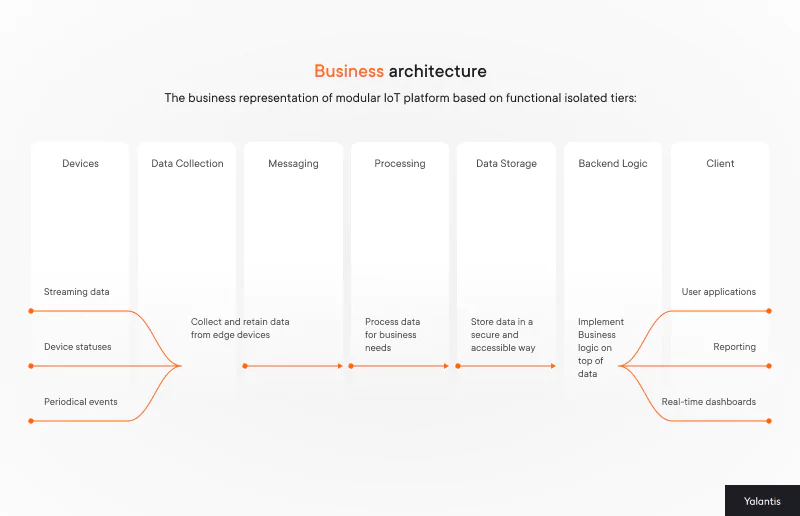
Bottom line
A BAS is one of the smartest investments businesses can make to cut utility costs. And this isn’t just for large enterprises – small and mid-sized businesses can also benefit significantly. The key is not to hesitate. The sooner you implement BAS, the sooner you’ll see the savings.
When deciding between ready-made vs. custom BAS, remember: what you invest in development now will pay off in the long run. A custom solution means:
✅ One system for all your buildings. No need to juggle multiple platforms.
✅ Designed for your needs. No unnecessary features, no compromises.
✅ Full flexibility for future scaling. Expand without vendor restrictions.
✅ No vendor lock-in. Own your system instead of paying endless licensing fees.
With years of expertise in IoT-enabled building automation, a dedicated 50+ person team, and a track record of success, we know how to create BAS solutions that are perfectly suited to your business needs. Whether it’s about integrating sensors, AI-driven analytics, or full-scale automation, we’ve got you covered. Get in touch with us, and let’s find the best approach for your project.
Want to cut costs and take control of your building?
Let’s build your custom BAS together.
FAQ
How long does it take to develop a Building Automation Control System?
If you decide to partner with Yalantis, the timeline for developing Building Automated Systems depends on your starting point:
- If the sensors are already in place, we can develop an MVP in 4-6 months.
- If starting from scratch, including hardware selection and integration, expect 6+ months for a fully functional system.
Plus, we can implement our ready-made IoT platform to speed up development time by 30% and cut extra costs.
What’s the difference between Building Automation Solutions (BAS) and Building Management Systems (BMS)?
BAS controls specific building functions like HVAC, lighting, and security, automating them for better efficiency. It adjusts temperature, turns off unused lights, and manages energy use based on real-time data. BMS is the bigger picture. It connects multiple BAS systems into one centralized platform, giving building operators full control and insights.
While BAS handles the tasks, BMS is the dashboard that monitors everything, helping optimize performance, detect issues, and improve long-term efficiency.
What are the different types of Building Automation and Control Systems?
Building automation control systems come in different types, depending on the building’s needs:
- HVAC automation optimizes heating, cooling, and ventilation to cut energy costs and maintain comfort.
- Lighting control adjusts brightness based on occupancy and natural light to save electricity.
- Security & access control manages surveillance, alarms, and entry systems for safety.
- Energy management tracks and reduces utility usage through smart monitoring.
Some buildings use a single system, while larger facilities integrate multiple building automation and controls into a centralized system.
How much does a BAS system cost?
It depends on the scale of your business and the company you are working with. At Yalantis, we have such cost estimates for a single environment:
- $500/month – a good start for small setups and MVPs.
- $2,000/month – ideal for mid-sized businesses with more automation
- $4,500+/month – full-scale, enterprise solutions with deep customization
Need a more precise estimate? Let’s talk!
Rate this article
5/5.0
based on 21 reviews



